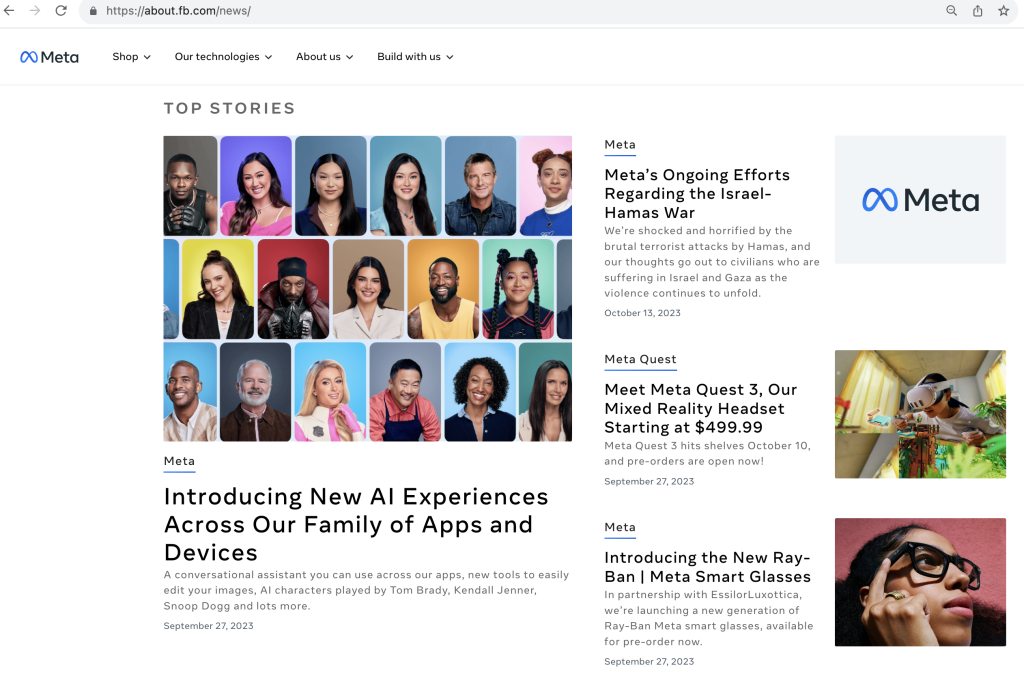It is not possible to write cheerfully about new innovations when the world is on fire. Especially not when the world's most widespread innovation of this century, social media, is being used by terrorists and imbeciles to spread hatred and prevent peace.

Historian Yuval Noah Harari aptly summed up the misery on CNN: the goal of Hamas and related clubs is simple, namely, "to assasinate any chance of peace." Spreading their atrocities through social media is a deliberate tactic in doing so. The hatred and disgust evoked by the images will eradicate any sense of compassion, let alone willingness to compromise. Exactly the intention of Hamas.
It proved virtually impossible on Facebook, Instagram, TikTok, X and Youtube last week to avoid the topics of Israel and the Gaza Strip. This seems logical at first, were it not for the fact that I was continuously served messages from all sorts of people I do not follow at all. No matter what I clicked away and pushed away, the distasteful nonsense from Gaza experts, many of whom were self-proclaimed AI experts until last week and NFT insiders last year, kept flooding my timeline.
Facebook and TikTok respond only after warnings
It took until Friday for Western governments to issue warnings. The EU ordered Meta to do something about all the disinformation being poured out over the world via Facebook and Instagram. Zuckerberg, meanwhile, understands that you have to move then, just as someone running a red light always pretends to cross as fast as possible. TikTok received a similar warning, as did YouTube.
The statement Meta issued is so saltless and heartless that it must have been written by a bad AI application. But look especially at where Meta places that statement: small in the right-hand column. The most important place on a website, big in the middle with animated visual, is still dedicated to the boring chatbots that were already announced on Sept. 27.
Next time a Facebook livestream by Hamas terrorists wearing smart Ray Bans?
Zuckerberg was able to chat with Lex Fridman in a promotional podcast about his Metaverse efforts last month, but where was he last week when terrorists broadcast child murders over his networks? Sure, it's brave for a nerd to spar with professional cage fighters, but it takes real courage to go live on CNN to talk to Christiane Amanpour about your contribution to the spread of terrorist outrages.
Meta's news page pays more attention to the new Meta Smart Ray Bans, which allow live streaming from a camera in those glasses on Facebook and Instagram, than to what Meta will do against abuse by groups like Hamas.
If Zuckerberg doesn't intervene, the wait is on for a Hamas idiot (fighter is the wrong word for someone who kidnaps a girl at a music festival) with a fashionable 'Rebel Black Headliner Ray-Ban Meta' smart glass on his head committing mass murder; because it's easier to operate your Kalashnikov when you have your hands free while going live on Insta.
The business model of social media is free popular content
It's crude, but at its core, Hamas delivers what social media loves: lots of viewed free content. Meta's business model is to sell advertising through Facebook and Instagram to people who watch content for which Meta pays nothing. That's much more lucrative than all that cumbersome stuff from Disney or Netflix, who have to create expensive content.
At its core, Meta doesn't care what that content is, as long as they don't get hassled about it by advertisers. As Zuckerberg likes to say, "move fast and break things. The world has been able to see how that works out.
The problem is not new
Once a young Internet entrepreneur said:
"We are largely similar to the phone company. We only transmit information; we don't have a say about what is transmitted. We only select a little bit: if we passed on everything on the Internet, our computers would crash. And we also rejected a discussion group that did spread child pornography very clearly. But we could only tell that from the name of that group, because it would be impossible to read everything said in it."
That young Internet entrepreneur, that was me. And I said this in newspaper Trouw in November 1995, almost 30 years ago. I was 27 at the time and I sincerely believed that the operator of a network had no business meddling in the content that people transmitted over this network.
Not long after, several of our subscribers began distributing child pornography through newsgroups devoted to innocent topics such as bird watching or stamp collecting.
We had worked for years as communications science graduates to build an Internet provider that would provide Internet access to everyone in the Netherlands, allowing people to communicate and gain knowledge, but a certain group of subscribers decided to spread the worst imaginable misery through our network.
Filter freedom of speech
In all civilized countries there is a limit to freedom of speech somewhere. I didn't know then and I don't know now exactly where that line is, but we all know when it is crossed by miles.
We actively reported our own child pornography distributing subscribers to the vice police, which led to several criminal cases. It was the darkest period of my time as an entrepreneur and they were the worst things I have ever seen. I was deeply impressed by the commitment and professionalism the police showed in these cases. The detectives always looked immediately to see if the images were already known, so that hopefully there were no new victims. Fortunately, this was true in all cases.
With pain in our hearts, we closed access to many newsgroups, thus limiting both subscribers' access to information and their ability to disseminate information. The good people suffered from the bad people, because 99% of the messages could be classified as normal communications.
Therefore, I can well understand that Mark Zuckerberg and other entrepreneurs and executives who have worked hard to build their networks find it difficult to now have to limit and control what they have built. But global reach and influence comes with commensurate responsibility, to which Zuckerberg in particular seems blind.
No new glasses, but working filters
Meta, X, TikTok and YouTube should now not focus at all on developing technology that will make it even easier for everyone to distribute even more content, such as via an avatar in the Metaverse or with smart glasses with built-in cameras; the focus should be on regulating which users broadcast what content over their networks and who has access to viewing that content.
The same kind of algorithms that YouTube and Facebook use to see what content is going viral and promote it faster can also be used to estimate what content needs to be looked at more closely for objectionable substance. Good use of the lightning-fast developments in AI and text and image recognition should be able to limit spread of much misery.
Meta's market cap is over $800 billion and the company makes tens of billions in profits. That's more than enough budget to build functioning systems. The same is true for YouTube and TikTok, while the ailing X is surely able to get a loan from its owner Elon Musk.
Over the past week, children around the world have seen images on Instagram and TikTok that no one should ever see. Preventing that misery is what Zuckerberg, Musk and the other chiefs of social media should focus on.
Four years ago, Zuckerberg had a long conversation with Yuval Noah Harari. It would be good for them to talk again now. The value of democracy is at stake.If America (Meta, YouTube, X) has moral superiority over China (TikTok), now is the time to prove it.


